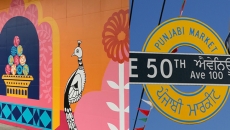A unique preserver of heritage and history, Wanjara Nomad Collections offers an exquisite collection of artifacts from historical moments of Sikh history spanning centuries. Wanjara Nomad Collections has curated a unique collection of antiques to gather and reconstruct the story of Sikhs to preserve, learn, and share it. The ultimate objective is to comprehend, safeguard, and distribute their unique collection from various continents and origins to showcase how Sikhs perceive the past, present, and future in a horizontal, vertical, and thematic dimension. The collection shares a modest selection of books, medals, maps, albums, and ephemera, hoping to inspire and prompt others to preserve history on a singular level.
The abode of the Wanjara Nomad Collection includes an array of breathtakingly beautiful items with profound cultural and historical significance. From rare art to important antiquities, each piece is a unique and meaningful representation of the rich and diverse history of the Sikh Panth and beyond. On the auspicious occasion of Vaisakhi, we bask in the spirited glory of seven unique artifacts from the Wanjara Nomad Collections:
Sri Guru Granth Sahib Ji Aad, Nanakshahi Samat 439
This 117-year-old embossed print of Sri Guru Granth Sahib Ji, one of four volumes in existence across the globe, is a remarkable religious treasure that has stood the test of time. The unique seal belonging to the King of Faridkot, Raja Bikram Singh Brar, illuminates when placed under light, enhancing the print's overall beauty and uniqueness. The embossed impression of the bani creates a profoundly spiritual experience that connects the reader to the divine teachings within. Guru Granth Sahib Ji provides guidance and inspiration to millions worldwide as a cosmic axis of the Sikhi. The Sikh Panth holds the preservation and veneration of bani in the highest regard, ensuring its sanctity and sacredness remain intact. This historic print is a testament to the community's unwavering devotion and commitment to preserving the religious heritage of the Sikh faith.
Signature of Maharaja Duleep Singh, 1838-1893
A rare and valuable artifact, this is the original signature of Maharaja Duleep Singh, the last Maharaja of the Sikh Empire and the youngest son of Maharaja Ranjit Singh. Maharaja Duleep Singh was the last Maharaja of the Sikh Raj and the youngest son of Maharaja Ranjit Singh. He was exiled to Britain as a child, where he lived a turbulent life and was eventually separated from his heritage and culture. A significant figure in the history of the Sarkar-E-Khalsa, Maharaja Duleep Singh has lived a life that highlights the complexities of colonialism and its impact on individuals and cultures. This artifact provides a tangible link to the Maharaja and his story. As a symbol of his identity and legacy, the signature serves as a reminder of the struggles and triumphs of the Sikh Empire and its people, as well as the enduring power of heritage and culture.
The Baisakhi of Guru Gobind Singh, Kapur Singh, 1959

This unique artifact is a book that holds both sentimental and historical value. It was gifted to Ahsanuddin Pir on September 10, 1960, in Simla, making it a cherished possession for someone at some point in time. The book is a first edition from 1959 and contains a handwritten note in Urdu on the first page, adding to its personal touch. Parasaraprasna ("The Questions of Parasara'') is a masterpiece by Kapur Singh, a renowned theologian and national professor of Sikhism. The book was born from scholarly discussions between Singh and Shri Sardari Lal Parasara, the Principal of Simla's Government School of Arts. Every page showcases Singh's profound erudition and insightful interpretations of various aspects of Sikh identity and institutions. This book is not just a literary work but a glimpse into the intellectual and spiritual world of a prominent Sikh scholar.
Nanakshahi Coin Seals, 1831-1840

The Nanakshahi coin seals are a unique artifact from the Sikh Empire that was used on Nanakshahi coins during the reign of Maharaja Ranjit Singh. These seals feature the "Akal Sahai Nanak Ji" text, which translates to "Victory belongs to the timeless one, Nanak." Issued from 1831 to 1840, the Nanakshahi coins were the first to feature the Sikh emblem, the Khanda, on one side and the name and title of Maharaja Ranjit Singh on the other. These coins were in circulation in the Punjab region and beyond, serving as a tangible symbol of the Sikh Empire's economic and political power. The Nanakshahi coin seals are important artifacts as they link to the history of the Sikh Empire and its currency system. They also highlight the significance of Sikhism in the region's culture and identity and demonstrate the fusion of spiritual and temporal power that characterized the Sikh Empire.
A Dissertation of the Proper Names of the Punjabis, 1883
This artifact, "A Dissertation of the Proper Names of the Punjabis: With Special Reference to the Proper Names of Villagers in Eastern Punjab," is an important anthropological study that delves into the origins of Sikh, Hindu, and Muslim names in the Eastern Punjab region. The book, first published in 1883, provides insight into the cultural and historical background of names in the region, shedding light on the diverse influences that have shaped the identities of the people living there. This artifact is valuable for those interested in tracing their family history or understanding their cultural roots. Names are an integral part of identity, and knowing where names come from can help better understand and appreciate heritages. Additionally, the book offers a window into the past, providing a glimpse into the cultural and social practices of the Punjabis over a century ago.
Map of Punjab, 1839

This 1839 map of Punjab with parts of Afghanistan, Kashmir, and Sinde is a valuable artifact that provides a glimpse into the region's political and geographical boundaries during the Sikh Raj. The map was created a decade before the fall of the Sikh Empire, making it a rare and precious piece of history. While digital copies of the map exist, physical copies are scarce because of the British policy of destroying books, maps, and other cultural artifacts during the Anglo-Sikh wars. As part of their efforts to undermine the power and influence of the Sikh Empire during their colonization of Punjab in the mid-19th century, the British employed a tactic of paying civilians to sell books, maps, and weapons, which were then confiscated and destroyed. This was part of a broader strategy to suppress Sikh culture and impose British values on the population. Much of the burned metal exists in Anglo-Sikh war memorials today, acknowledged by historians. The survival of specific physical maps is paramount to comprehending the history and geography of the region, as they serve as vital artifacts offering insight into the existence of the Sikh Raj.
Punjab Gun License, 1945

This Punjab Gun License from 6-1-1945, issued in British India, provides valuable insights into the region's political and social climate before the Partition of India. The license's conditions give us a glimpse into the bureaucratic process of gun ownership, including the licensee's name, residence, and authorized arms and ammunition. It also required the retainer's name and address and the extent of the license's validity. The licensee's historical significance lies in its connection to the broader context of the Partition of India, marked by communal violence and the forced migration of millions of people. Printed by Lahore's prominent publishing company, C&M Gazette Ltd, during the British Raj, the license sheds light on the political, social, and cultural factors that shaped the region's history. It highlights the government's attempts to maintain order during a period of upheaval, offering a window into the past and reminding us of the need to preserve our heritage for future generations.
Preserving artifacts such as the ones lovingly protected by Wanjara Nomad Collections is an incredible and noble effort, as it enables us to keep the memories and stories of our communities alive, providing a tangible link to our past and heritage, which is especially relevant during the celebration of Vaisakhi, a time when we honor the legacy of our ancestors and the principles of freedom, justice, and equality they fought for.
As Raj Singh Bhandall of Wanjara Nomad Collection puts it, the initiation rites of the Five Beloved Ones by Guru Gobind Singh Sahib marked a significant turning point for the Sikh Quam. It called for a spirit of cooperation and unity, urging the elimination of divisive and oppressive practices of the past. The Nash doctrine espoused abandoning previous occupations, family ties, creeds, karma, and superstitions in favor of the belief in Ik Onkar (Waheguru). It aimed to confront the old-fashioned and free the Sikh Panth from the shackles and bondage of castes and outdated traditions. The Khalsa collective embodied individuals who demonstrated complete faith and love in the Waheguru. Both men and women are considered equal and are encouraged to lead a life of righteousness, service, and devotion to God. The names "Singh" and "Kaur" symbolize this equality and remind Sikhs that they should strive to embody the virtues of courage, strength, dignity, and independence, regardless of their gender. Bhandall shares, "Guru Gobind Singh Ji's greatest act of genius was transferring the Patshahi Dava vested in him to the Khalsa Panth. The Sikh Panth became a living spirit with a different constitution of the mind and elevated and altered physical frames by the imprint of Guru Gobind Singh Ji. Hum Rakhat Patshahi Dava."









